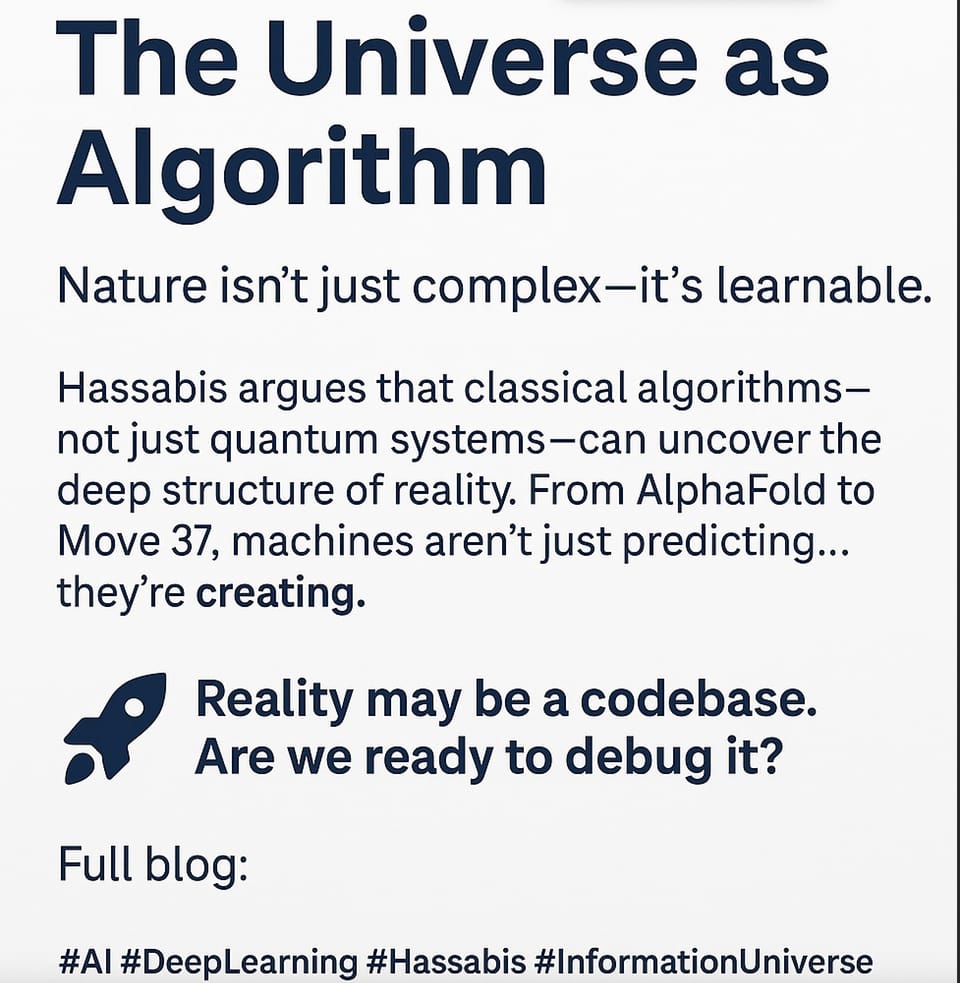The Universe Might Be One Giant Learning Algorithm

Imagine this: every leaf, cloud, and cell as lines of code—what if reality is a learning algorithm waiting to be unraveled?
Welcome to the Information Universe Hypothesis.
In a recent discussion between Demis Hassabis and Lex Fridman, Hassabis laid out one of the boldest frameworks in modern science: that information—not matter or energy—is the most fundamental building block of the universe, and that the patterns we see in nature are not just coincidental complexity but the product of a reality designed to be learnable.
From Patterns in Nature to Programmable Reality
Recent breakthroughs prove this isn’t intellectual daydreaming.
AlphaFold deciphered the enigma of protein folding in months—what stumped biology for 50 years. AlphaGo charted moves in the game of Go that humans never imagined, not by brute force but by uncovering new, learnable order within chaos. In each case, a classical algorithm—machines running on silicon, not hypothetical quantum power—unveiled structures that evolution “locked in” for being stable and predictable.
Hassabis’s leap:
“Any pattern that can be found in nature can be efficiently modeled by a classical algorithm.”
Why Information Comes First
If you think of information—relationships, rules, ratios—as truly primary, matter and energy become side effects of deeper programmatic laws. The universe isn’t random: it’s a data structure. Physics? Just an elegant way the universe compresses and transmits its data. Chemistry? Nature’s search for the most robust algorithms. Life? The most persistent program in the system.
Tangible Implications Across Fields
Biology & Medicine:
Virtual cells could test drug responses, mutate, and learn thousands of times faster than traditional experiments, shifting pharmaceutical development from years to weeks.
Engineering & Materials:
Mapping arrangements of atoms as “learnable patterns” could unlock self-assembling materials, adaptive infrastructure, and breakthroughs in manufacturing intelligence.
Climate Science:
Earth’s complex weather and climate feedback loops can be reframed as gigantic, learnable systems—subject to data-driven mitigation previously considered impossible.
The Classical vs. Quantum Debate
For decades, the mantra was: Only quantum computation can solve complex natural mysteries. Hassabis’s camp pushes against that. With classical algorithms already cracking what millions believed impossible—such as protein folding and ultra-realistic video physics—the question now is: which puzzles truly demand quantum, and which can already be solved with today’s computational tools?
Beyond Prediction: Toward Creative Discovery
The real power of this informational view isn’t just simulating the present. It’s about inventing the future—new molecules, ecosystems, or phenomena that evolution or nature hasn’t even tried. Machines don’t just forecast—they create.
Reference Move 37 in Go:
An unexpected, “inhuman” strategy that changed the game forever. Machines capable of similar leaps could bring entirely new dimensions to science and technology.
Call to Action
To those in research, product development, and scientific leadership:
Move beyond data as recordkeeping. Treat your field like an evolving codebase. Make space for algorithmic pattern discovery, invest in scrappy data-first initiatives, and collaborate beyond silos. Recognizing that the universe is not just a passive system, but an active code to be decoded, is how we’ll find the next era’s greatest breakthroughs.
Are we ready to think of science—and reality itself—like a learning machine?
Reply and share your thoughts. And if you want a deep dive, watch for my next edition:
“P vs NP as Physics: When Computational Limits Define Reality.”
Stay curious, stay rigorous, and keep decoding.




